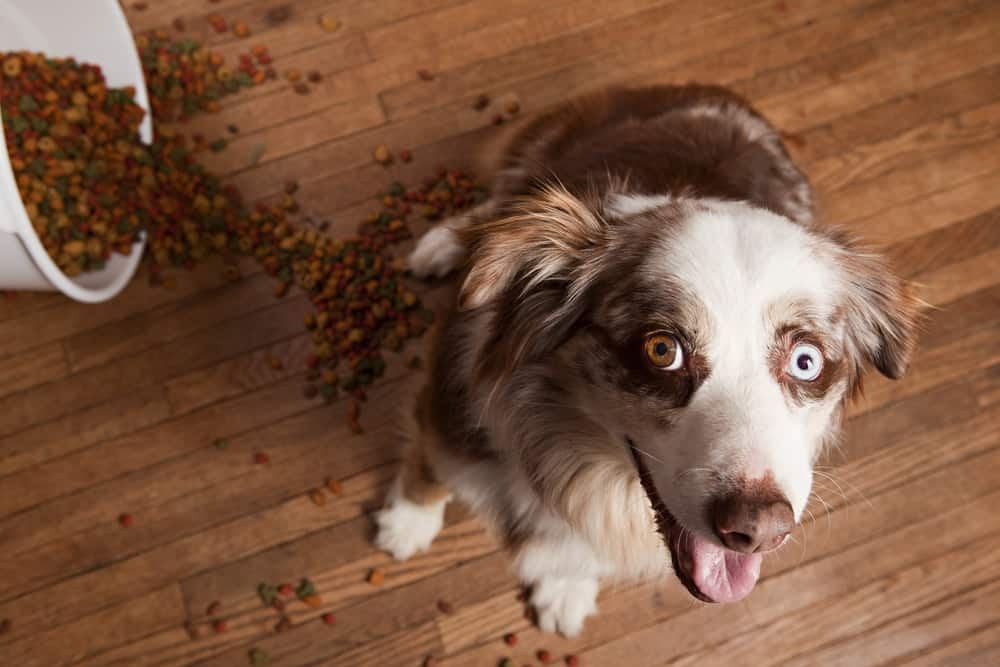“This post contains affiliate links, and I will be compensated if you make a purchase after clicking on my links.”
Once pet food is exposed to air or light, a process called “oxidation” occurs and food can become rancid quickly. We spend a lot of money on dog food, particularly if it’s a premium food, and that makes it more important than ever to learn how to properly store it. This is your guide to storing pet food.

First up, always check for a ‘best if used by’ date on the container or bag before buying. Some stores use an inventory method that rotates bags to place the “expiring” food up front. Others may not be aware of expiration dates or best buy dates.
Dry Food:
Manufacturers spend a lot of time and money researching the best ways to store food and extend shelf life, so storing dry food in their original bags is an excellent first step to keeping food fresh. However, the package must be tightly resealed after opening. Store dry pet food in a cool, dry place, preferably in an airtight container, out of the light.
Many pet parents find that opening a bag of dry food and lowering the entire bag into a dog food storage container best preserves freshness and helps to keep the food safe from rodents and insects. Vittles Vaults are one of our favorite airtight, opaque pet food storage containers designed especially for keeping pet food fresh and allow pet owners to more easily buy in bulk.
Note: Lamb-based dog foods have a much shorter lifespan than other meats, so if you regularly rotate your dog’s protein source, remember to check freshness dates as they may vary.
Canned Food:
Most unopened canned pet foods have a fairly long shelf life and will safely stay good for 2-5 years if stored properly, but remember that ingredients and canning methods will impact how long they can be stored. Canned dog foods packaged in plastic tubs will generally not last as long on the shelf as those in actual cans.
Keep a close eye on the “use by” dates. After purchase, move the older cans to the front of the shelf and put the newer ones in the back or use a can organizer for your pantry. That will help ensure you use them in the right order.
Once a can has been opened, you can transfer the unused portion to a small, airtight storage container or use a tightly fitted can lid and refrigerate the food for up to five days, depending on ingredients.
Freeze Dried or Dehydrated Foods
Since most freeze dried foods rely on natural antioxidants, they have shorter shelf lives than other foods. As soon as you break the seal on these foods, the clock is ticking and you should plan on consuming within a few weeks.
Moisture is a deadly enemy to these types of foods, so it’s important you store in a cool, very dry place so bacteria and mold does not grow. Without repacking these foods, you only have about 6 months to feed dehydrated or freeze dried food to your pets.
However, these types of foods are very easy to repackage. If you do choose to repackage, transfer the contents into airtight packages and store in a cool, dry place or freeze. This can extend the shelf life to between 2-5 years.
Raw Food
Raw food is not intended to be stored for long amounts of time. Always use raw food within 1-2 days of opening or thawing (if frozen).
Generally, frozen raw food will stay good in a frozen state for about 6 months if sealed or wrapped properly. Once food is opened or thawed, you have fewer than 3 days to use it. If you make or buy raw or frozen food in bulk, portion it out into sealed containers and freeze. This helps you preserve the life of the food while only thawing the portions you need to feed each day.
Reminders
Because all dog foods have different ingredients, preservatives, and packaging types, shelf life and use-by dates will vary between brands and types. The type of preservatives used may also affect the shelf life of a pet food. Natural preservatives (such as vitamin C, vitamin E, citric acid, and some types of herbs) tend to break down more quickly than artificial preservatives (like ethoxyquin, BHT, and BHA), making natural or holistic pet foods more susceptible to spoiling more quickly.
Use the guide above as a general rule for keeping food fresh and always refer to manufacturers’ recommended storage guidelines. When it comes to your pet’s food, when in doubt, throw it out.
How do you store your dog’s food to keep it freshest? Please, share your experiences in a comment below!















carol wickham
Mar 24, 2020 at 9:11 pm
I have fed my dogs Natural Balance Grain free to my last 5 dogs – all living until they died of natural cases at ages 1-12. I have large breed dogs – two from Show Working Class and two from Sporting Class. All have been show dogs, and done well on weight management and wonderful show coats. I still have one 12 year old setter who has super coat, good weight and health.
John Hicklin
Jul 2, 2019 at 5:02 am
Informative & brilliant article. I have a cutey puppy & your idea will be very very helpful to me. Thanks a lot. Go ahead.
Helen
Sep 9, 2018 at 4:06 am
The bag that the kibble comes in is designed to keep the food fresh. Store the bag inside a container if you have vermin. I decant the canned food (small cans) into a glass container in my fridge and it’s used up in about 4 days. I don’t like my food from a tin stored in a fridge so I don’t think kitty does either. Thanks for the awareness.
Shana Hendrickson
May 20, 2018 at 4:09 pm
After a nationwide mealworm incident with a major manufacturer’s brand, we’ve been using Royal Canin in resealable bags
Jennifer Wood
May 12, 2018 at 12:21 pm
This is a great article, thanks for sharing.
Patti McDoggy
May 10, 2018 at 4:08 am
I buy small bags of dry food then in one of those old popcorn tins. The lid is tight and the food stays cool in there.
Daisy
May 6, 2018 at 10:27 am
Great article, I tried raw feeding my dog 2 days ago and she love it. Thank you for sharing this.